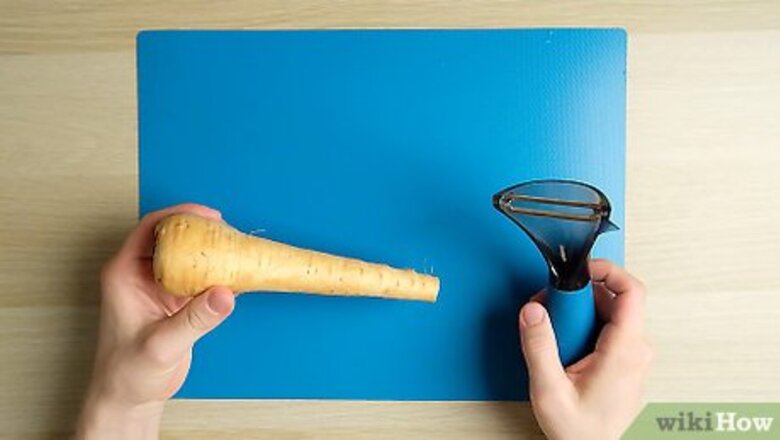
views
Peeling and Trimming Parsnips
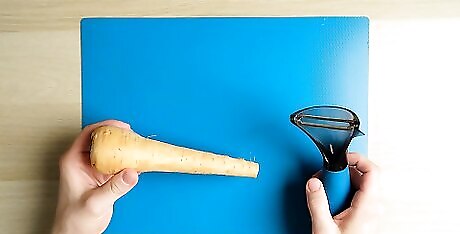
Hold a parsnip in one hand and a vegetable peeler in the other. Since parsnips are part of the carrot family, their tough skin can be peeled off in a very similar way. Hold the narrow end of the parsnip in your non-dominant hand and a sharp handheld vegetable peeler in your dominant hand. To catch the peelings, hold the parsnip over a bowl, sink, or a disposable bag. This makes it easier to discard the peelings once you’re done.

Run the peeler blade along the parsnip’s skin. Near the point where you’re holding the parsnip, dig the vegetable peeler into the parsnip so it creates a notch into the tough skin. Carefully slide the peeler blade down the parsnip, moving the tool away from your body, until you peel off a piece of skin. Small baby parsnips with tender skin don’t need to be peeled. Just scrub them under running water and discard the ends before slicing them.
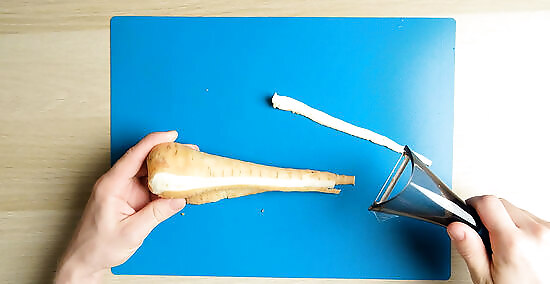
Rotate the parsnip to peel away all the skin. Once you’ve removed 1 or 2 strips of skin, turn the parsnip in your hand clockwise to expose every side. Peel away all of the skin that you can while holding the narrow end of the parsnip. Then flip it over so you’re holding the thicker end. Run the peeler below the skin at the slender end, turning it in your hand as you go, until the whole vegetable is free of skin. Refrain from carving away too much of the inside of the parsnip since a lot of flavor and nutrients live right below the skin.
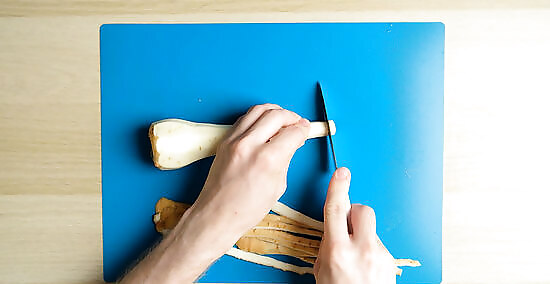
Trim off the taproot or bottom tip of the parsnip with a vegetable knife. Once you’ve peeled all of your parsnips, bring 1 over to a cutting board. Lay it down lengthwise with the bottom tip facing your dominant hand. Use a sharp vegetable knife to chop off the bottom tip first. Remove roughly the bottom ⁄4 in (0.64 cm) of the parsnip. The small tip at the bottom of a parsnip is the taproot. This part was deepest in the soil when the vegetable was still growing.
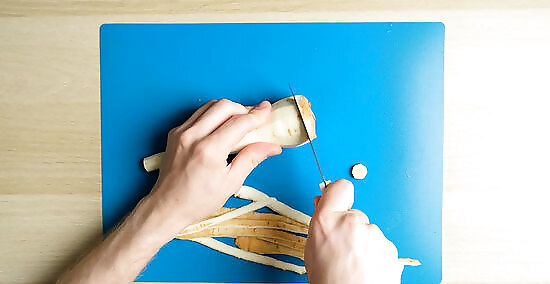
Cut off the shoulder or the top end of the parsnip. Rotate the parsnip 180 degrees on your cutting board, so that the thicker top end is facing your dominant hand. Chop off the top ⁄4 in (0.64 cm). Then discard the top and bottom ends along with the peelings. The thicker top part of a parsnip, called the crown or shoulder, is where it was connected to its above-ground leaves. Be sure to remove any stubby remains of the stem at this point.
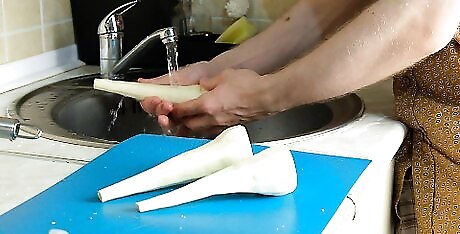
Rinse off the parsnip under running water. Place all of your peeled parsnips in a colander. Set this in your kitchen sink and run water over it. Feel free to jostle the parsnips so that all sides get rinsed off. Continue rinsing until any bits of soil are removed and the parsnips are clean. Now your parsnips are ready to cut up!
Slicing Julienne Strips
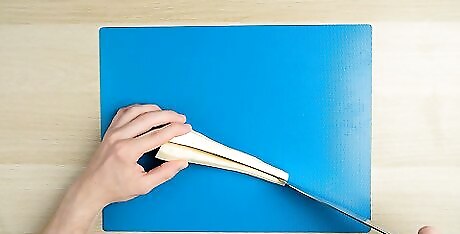
Chop each parsnip in half lengthwise. Once you’ve peeled and trimmed away the ends of your parsnips, cut each one down the middle using a sharp vegetable knife. Insert the knife into the thicker portion of the parsnip, with the blade roughly in the center, lengthwise. Press the blade down into the vegetable to split it in half. Once your knife is inserted into the top of the parsnip, you can use your other hand to stabilize both sides of the parsnip as you finish off the cut. But keep your fingers away from the blade. Now each half will have a flat side and a rounded side.
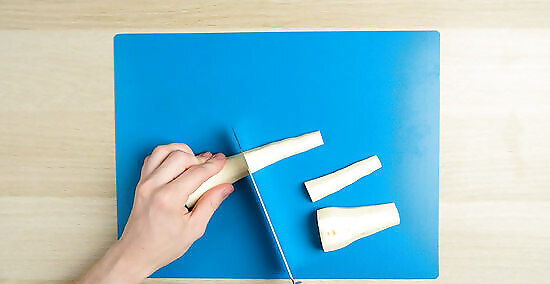
Divide the parsnip halves into 2 to 3 in (5.1 to 7.6 cm) long pieces. Place one of the halves flat-side down on the cutting board. Turn it so the long end of the parsnip is perpendicular to your knife. If you have small parsnips, chop each piece in half crosswise. Or, if you’re slicing up a large parsnip, divide it into 3 or 4 sections with crosswise cuts. Aim to make each piece roughly 2 to 3 in (5.1 to 7.6 cm) long. They should be roughly the same size so all of the pieces cook evenly.
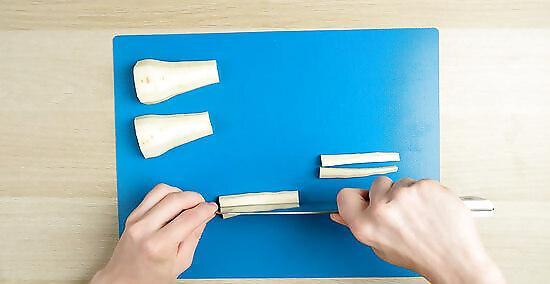
Slice the slender pieces in half lengthwise for ⁄2 in (1.3 cm) wide matchsticks. The bottom end of a parsnip is much narrower than the top. Place the bottom ends flat-side down on your cutting board and chop them in half lengthwise, 1 at a time. Aim to make ⁄2 in (1.3 cm) wide strips. If you’re cutting up a baby parsnip, you may be able to leave this bottom end whole since it won’t be thicker than ⁄2 in (1.3 cm) anyway.
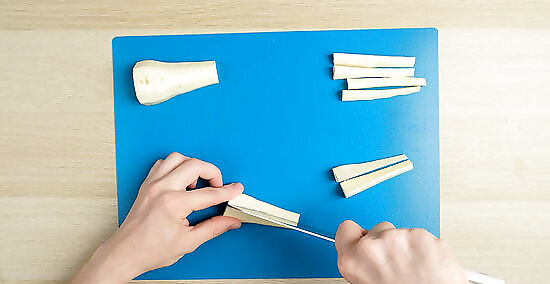
Cut the thicker pieces into quarters for ⁄2 in (1.3 cm) wide matchsticks. The pieces from the top and middle of the parsnip will require more cuts to get them down to the right size. Cut each of these larger pieces in half lengthwise, and then in half lengthwise again. In the end, you should have julienne strips measuring roughly 2 to 3 in (5.1 to 7.6 cm) long by ⁄2 in (1.3 cm) wide. If any of your matchsticks are still too thick, divide them in half lengthwise once again. All of the pieces should be about the same width so they cook evenly. While it’s not essential, you could remove the cores at this stage.
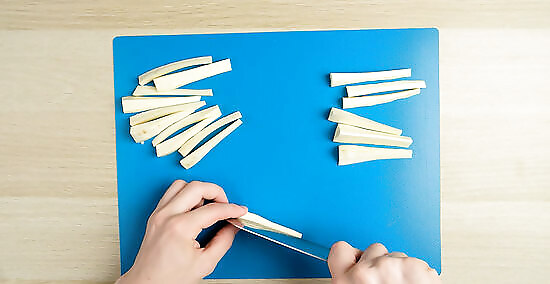
Slice each matchstick in half lengthwise for ⁄4 in (0.64 cm) pieces. If you want really slender julienne strips, chop each ⁄2 in (1.3 cm) wide matchstick in half lengthwise. This will result in julienne strips measuring about 2 to 3 in (5.1 to 7.6 cm) long by ⁄4 in (0.64 cm) wide.
Cutting Disks on the Bias
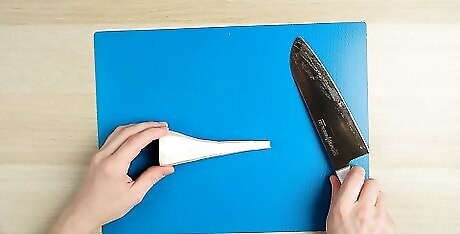
Hold a parsnip securely on the cutting board. First peel, trim, and rinse off your vegetables. Then place a parsnip on the cutting board, with its long end perpendicular to your body. Stabilize the thick end of the parsnip with your nondominant hand and hold a sharp vegetable knife in your dominant hand. By slicing the whole parsnip on the bias, you’ll end up with oval-shaped disks. Feel free to slice the parsnip in half lengthwise and lay the flat side on the cutting board if you prefer half-moon pieces.
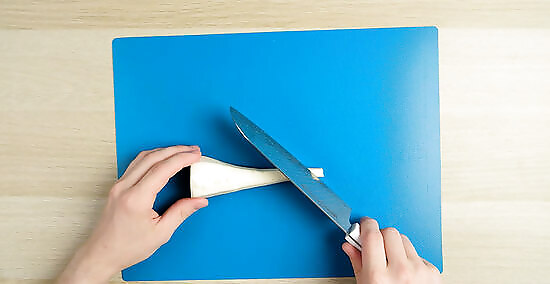
Hold your knife at a 45-degree angle at one end of the parsnip. Starting at the narrow end of the parsnip, position the knife at a 45-degree angle in relation to the vegetable’s core. Angle the tip of the knife towards the center of your body, rather than fanning it out towards your shoulder. Don’t bother coring the parsnip if you’re cutting it on the bias. This technique makes tougher vegetables a little softer and easier to chew once they’re cooked.

Make cuts at a 45-degree angle along the length of the parsnip for disks. Press the knife into the parsnip to make each cut. Space each cut so that you reach the desired thickness for each slice. Continue cutting the parsnip at this angle until you reach the end, near where your hand is holding it for stability. For thicker disks, place your cuts ⁄4 to ⁄2 in (1.9 to 1.3 cm) apart. Create thinner disks by making cuts ⁄4 in (0.64 cm) apart. One main benefit of cutting disks on the bias is that you end up with more surface area. This way, the parsnips require less time to cook and will look attractive if you roast them until the edges start to brown.
Coring Parsnips
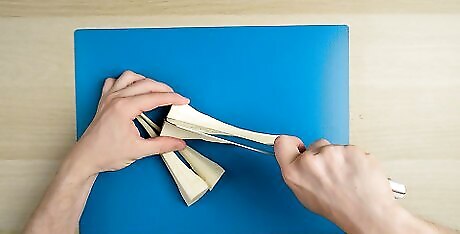
Cut the parsnip into quarters lengthwise. Peel, trim, and rinse off your parsnips. Then place 1 parsnip on your cutting board. Use a sharp vegetable knife to slice it in half lengthwise. Then place each of the halves flat-side down on the cutting board. Cut them in half lengthwise again. Each quarter should be roughly triangular in shape, with the central core exposed. Try to make your cuts down the exact center of the parsnip to evenly expose the core.
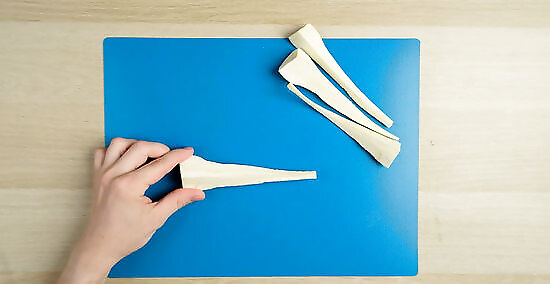
Stabilize a parsnip quarter on the cutting board, core-side up. Take 1 of the quarter pieces and place it on the cutting board so that it lays perpendicular to your body. Hold the thick end in your nondominant hand to stabilize it. When holding the parsnip piece, place your fingers on either side of the narrow strip, below the core.
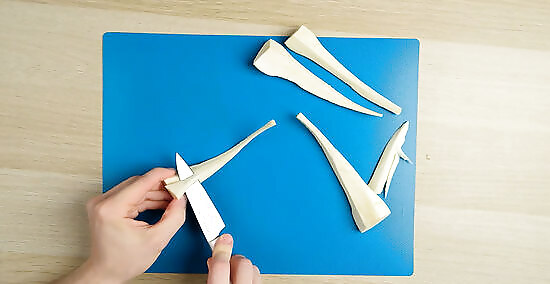
Run a sharp paring knife beneath the parsnip’s core. Hold the knife in your dominant hand, arranging the blade parallel to the cutting board and the parsnip. Insert the blade at the base of the parsnip’s core and slide it down the length of the parsnip to separate the core. Move the blade away from your hand as you do this, and feel free to pause and reposition your grip on the parsnip to better stabilize it as you go. The core has a tougher texture and will usually be slightly lighter or grayer in color. It will also typically feature a darker outline separating it from the rest of the parsnip. Don’t pull the knife towards your hand. Always move the blade away from your hand to avoid any accidents.
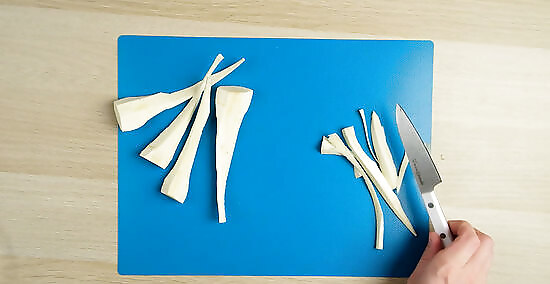
Discard the core for a more tender cooked parsnip. After removing the core from the first quarter of the parsnip, move onto the rest of the quarters. Cut out the core from each piece, coring 1 at a time, until you’ve separated the entire core from the rest of the parsnip. Some parsnips are curved so you won’t be able to get out every single part of the core. That’s ok though – with the majority of the core removed, your parsnips will still be nice and tender once cooked.
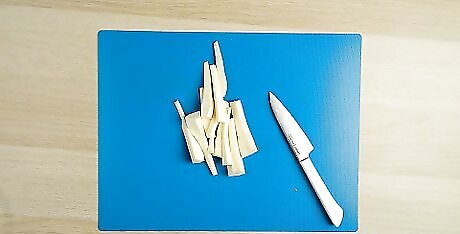
Chop the cored parsnip into similarly-sized chunks. With the core removed, make crosswise cuts into each of the parsnip quarters to your desired size. Try to make each chunk or cube roughly the same size so they cook evenly.




















Comments
0 comment